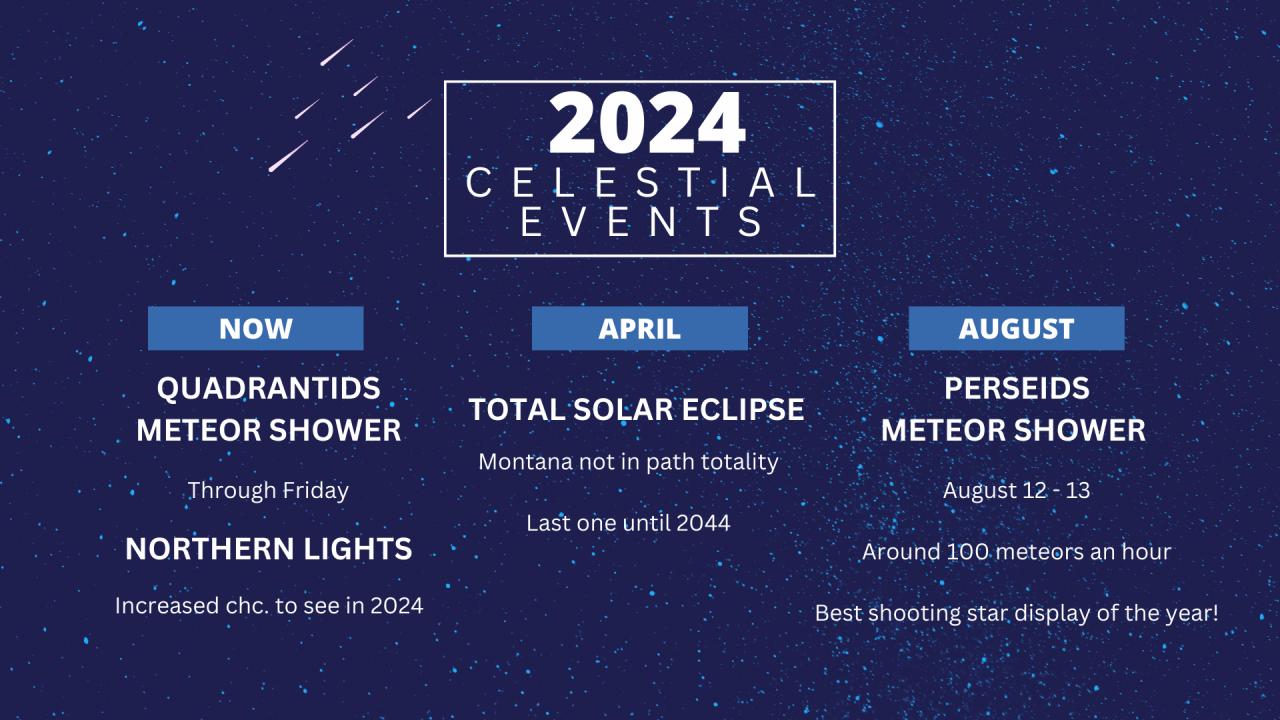Last year, observers across the U.S. witnessed an array of astronomical events including a beautiful “ring of fire” eclipse, dazzling meteor showers, and a partial annular eclipse.

This year in 2024, minimal equipment is needed to enjoy and view the events. The most anticipated events will probably be the long-awaited eclipse happening in April.
A solar eclipse is when the moon passes in between the Earth and the sun, completely blocking off the face of the sun. The last eclipse occurred in 2017.
While Montana isn't under the eclipse's totality, we will still get a good 40% to 60% view.
The next total solar eclipse to occur won't be until 2044! Luckily, Montana will be completely in the path for that one.

Happening now until Friday the 5th is the the Quadrantids meteor shower will be viewable with peak observation from 1 am to 5 am.
Around 25 shooting stars will be visible an hour, and with partly cloudy skies and 50% of the moons illumination, there are good odds to seem them.
Another meteor shower to write in your calender will be the Perseids meteor shower occuring on August 12th through the 13th.
The Perseids are caused by earth passing through debris — bits of ice and rock — left behind by comet Swift-Tuttle which last passed close to earth in 1992.” This will be the best shooting star display of the year with over 100 meteors visible an hour.
2024 will also be one of the best years for Montana residents to see the aurora borealis, often called the Northern Lights. Our current solar cycle is about to peak in 2024 to 2025 timeframe because on an increase in sun activity. This means that there will be an increase to see the northern lights in the treasure state.
To see them, drive out somewhere where there isn't a lot of light pollution, look up to the north, and you might catch a glimpse of the celestial event.

In Montana, the largest observatory is located at the Montana Learning Center near Canyon Ferry Lake east of Helena. The largest visual-use telescope available to the public is a 25-inch telescope, perfect for viewing nebulae, galaxies, and large deep sky objects.
Another telescope available to the public is a 14-inch robotic telescope that is equipped with a HyperStar unit and a 12M pixel color camera more suitable for imaging.
Ryan Hannahoe, the director of the Montana Learning Center Observatory says that the center offers several different programs for school related purposes, and personal-use purposes.
“For those interested in the night sky, around the first of the month, we post the Night Sky update. It's produced by NASA and we put it out over social media. And that that, you know, gives a really good snapshot of what's in store for that month.”
New programs are in store for the Learning Center this year, including a revival of their popular speaker stargazing series. This will bring in speakers around the US to talk about various astronomy topics. This will occur once a month around New Moon in the summer months.
“We like to introduce programs to get people excited about astronomy and the night sky.” Hannahoe added.
TRENDING:



